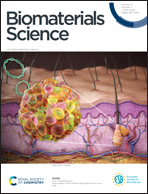Extracellular vesicles produced by 3D cultured MSCs promote wound healing by regulating macrophage activation through ANXA1†
Abstract
The conundrum of wound healing has transformed into an imminent medical challenge. Presently, cell-free therapy centered around extracellular vesicles (EVs) has become a pivotal and promising research avenue. EVs generated from three-dimensional (3D) cell cultures have been previously established to possess enhanced tissue regeneration potential, although the underlying mechanisms remain elusive. In this study, we observed higher expression of annexin ANXA1 in 3D-cultured EVs. Remarkably, 3D-EVs with elevated ANXA1 expression demonstrated a more potent capacity to promote macrophage polarization from the M1 phenotype to the M2 phenotype. Concurrently, they exhibited superior abilities to enhance cell migration and tube formation, facilitating expedited wound healing in animal experiments. Conversely, the application of an ANXA1 inhibitor counteracted the positive effects of 3D-EVs. Taken together, our data validate that extracellular vesicles derived from 3D-cultured MSCs regulate macrophage polarization via ANXA1, thereby fostering wound healing.



 Please wait while we load your content...
Please wait while we load your content...